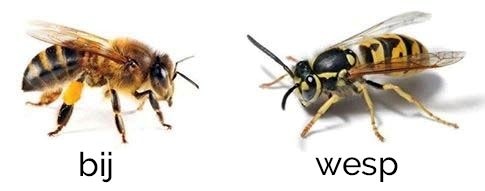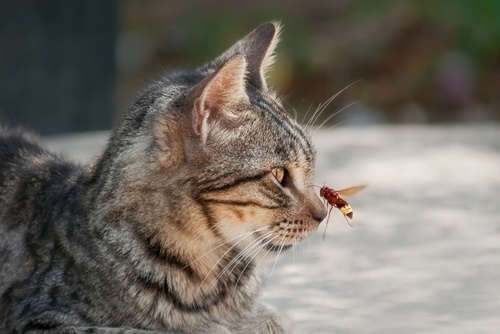- All products are added to your cart.
Help, my cat has been stung by a bee or wasp.
Insect bites are relatively common in cats. Cats enjoy playing, and insects are often a tempting prey. If your cat is playful and curious, it may accidentally get too close to a bee or wasp and get stung. In most cases, they heal naturally from a bee sting and only require a little bit of first aid. However, some cats may develop a life-threatening allergic reaction to a sting. Keep an eye on your cat for signs of allergic reactions and consider contacting a veterinarian.
-
Wasp Sting vs. Bee Sting
When your cat is stung by a wasp, for example, you will not find a stinger, whereas with a bee sting, the stinger may remain in the skin. A bee's stinger has barbs that keep it lodged in the skin after stinging. Bees don't sting quickly; only females sting and do so only when they are in danger. On the other hand, wasps can sting multiple times and are more likely to do so than bees. This makes wasps appear more aggressive. They can be particularly bothersome in August when they are searching for (sweet) food, which is often abundant in summer! If your cat interferes with or irritates a wasp by trying to play with it, there is a high chance it will become agitated and sting.

-
Signs of Bee Stings:
Cats often try to hide the pain, so it may not always be obvious that your cat has been stung by a bee. Younger cats and cats with outdoor access are proportionally more likely to get stung, but cats can be stung both indoors and outdoors, so it can happen to indoor cats too. Cats are usually stung around their face and legs. They may limp or scratch at the sting site with their paws. Look for a small, swollen bump where the sting occurred.

-
First Aid for Bee Stings:
As soon as you notice that your cat has been stung, remove it from the vicinity of the bee or wasp and find a safe place to examine and possibly treat your cat. Although it's unlikely that one sting will cause a severe reaction, there may be other bees or wasps nearby. Most severe reactions to insect bites occur when the cat is stung multiple times. If your cat is stung by a bee, it's important to remove the stinger quickly. Scrape out the stinger with the edge of a driver's license, credit card, or something similar. Scraping it sideways will pull the stinger out of the skin. Do not squeeze the stinger with tweezers, as it can crush the venom sac, making the sting worse.
After removing the stinger, examine your cat's injuries. Check your cat's fur to make sure there are no other insect bites. Monitor your cat's symptoms to see if there is no severe allergic reaction. Most insect bites do not require veterinary attention. Consider visiting a veterinarian immediately if your cat has been stung multiple times or if the insect sting occurred inside the mouth. In that case, it is advisable to call your veterinarian, regardless of where or how often your cat was stung.
If your cat only has mild swelling, a cold compress can help reduce the symptoms. Frozen vegetables, an ice pack, or a cold towel on the sting site can help reduce swelling and alleviate pain.
Use Beaphar wound spray to treat the wound; the wound spray soothes the skin. The propolis in the wound spray forms a protective layer and supports the skin's healing ability.
There are also medications available to reduce symptoms after an insect bite, but you should always be careful when giving over-the-counter medications to your cat. Read the label carefully to make sure there are no painkillers mixed in the medicine. Many painkillers are toxic to cats. The dosage also varies from cat to cat. If you are concerned about giving over-the-counter medications to your cat, contact your veterinarian for specific advice or skip the medication.
Even if the sting initially seems minor, keep an eye on your cat for signs of severe reactions. If symptoms of a severe allergic reaction occur, contact a veterinarian immediately.
Severe Reactions to a Sting:
Bee stings usually only cause minor swelling and discomfort for your cat. In rare cases, a bee sting can lead to an extreme reaction called anaphylactic shock.
Early Warning Signs:
- Diarrhea or abnormal bowel movements/urination
- Swollen snout or tongue
- Vomiting
- Itching
- Hives
Later Symptoms:
- Changes in behavior
- Weakness, lethargy, and excessive sleeping
- Weak pulse or increased heart rate
- Cold limbs
- Drooling
- Difficulty breathing
- Pale gums
- Collapse
If your cat shows symptoms of anaphylactic shock, contact your veterinarian immediately for possible treatment. All signs of anaphylactic shock should be taken seriously. Anaphylactic shock is often fatal if not treated immediately.
-
Preventing Future Insect Bites:
Bee stings will not be serious for many cats, but you can also take steps to reduce the likelihood of future incidents. If you let your cat outside, check for beehives around your home. Have a professional remove nests to make your environment safer. If you see your cat playing with an insect, make sure it's not harmful. If your cat tries to play with a bee or wasp, remove your cat from the situation immediately.
You can also place special wasp traps in the garden, but make sure your dog or cat cannot access them.
It is also important not to give your cat or dog any treats outside. Wasps not only like sweets but also enjoy meat and fish.
Chemical insecticides and insect repellents can reduce insect activity in your area, but they should be used with caution or, better yet, not at all. Chemical insecticides are often toxic to cats and can cause severe symptoms. Consider using other methods of insect control, especially in areas where your cat may be present.
-
In summary:
While some insect bites can be serious, most cats heal quickly after being stung by an insect. Providing first aid can help your cat feel more comfortable after a sting. Do not panic after an insect bite but treat the sting seriously. Knowing the signs of a severe reaction can save your cat's life.
---
Image source: Katho Menden/shutterstock.com


